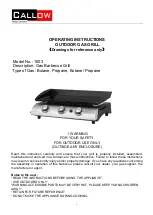
5
Metal Drilling
Use a sharp drill bit especially designed to cut the material you are working on. It
is recommended you use a cutting luid on the metal surface to avoid heat build-up.
MAINTENANCE
OPERATING PROCEDURES
CAUTION!
Always be sure that the tool is switched off and unplugged before at-
tempting to perform inspection or maintenance.
Inspect the tool before each use. Inspect the switch, the power plug and cord
assembly for damage. Check for loose screws, misalignment, binding of
moving parts, broken, cracked or improper mounting of the bits and attach-
ments, broken parts and any other condition that may affect safe operation. If
abnormal noise or vibration occurs, turn off the tool immediately and have the
problem corrected before further usage.
Do not use damaged equipment or serious injury could result.
Avoid overloading your angle drill. Do not force the tool. It will become hot and
lose efficiency. Running it free of load for a minute or two will allow it to cool
itself to normal temperature.
Brushes: This tool has two Carbon Motor Brushes (See Schematic Draw-
ing #19 on page 6) that should be periodically examined for wear. After long
use, the brushes in your tool may become worn. This may be evident from a
burning smell or excessive sparking visible through the ventilation holes while
the tool is running. To inspect or replace the carbon motor brushes:
1. Unscrew the black plastic Motor Brush Cover (See Schematic Drawing #18
on page 6) using a slot screwdriver slowly remove the cover as the brushes
are spring-loaded and may jump free, strike a hard surface, and chip.
!
2. Remove the brushes and examine the black rectangular carbon portions.
Examine the concave, wearing surfaces. They should be smooth and clean.
If there are large scratch marks, chips broken off and other damage, replace
both brushes immediately. When new, these are about 7/16” long
(see fig.
at right)
. We recommend they be replaced when worn about 1/2 way down
or at about 1/4”remaining.
After this point, they are not held at a steady angle
and constant pressure.
3. When the brushes are worn to 1/3 of their original length, about 1/8”, they
must be replaced or damage to the motor could result.
4. Insert the brushes so that the rectangular carbon portion slides in the slots in
the brass holders.
5. Replace the black plastic Motor Brush Cover over the brass cap, screwing it
in by hand to hold it in place.
7. Screw it down properly with a slot screwdriver. Do not over-tighten.
8. Always replace both brushes at the same time.
9. Keep the carbon brushes clean and free to slip in the holders.
When first using the tool with fresh brushes, you will notice a certain amount of
sparking. This is normal and will continue until the brush contact surface attains
a correct concave profile to match the rotor on the moto
r.
Keep the tool housing clean; free of oil, and grease. If necessary, use mild
soap and a damp (not wet) cloth.
DO NOT
let solvents like brake fluid, gaso
-
line, petroleum-based products, etc., contact plastic parts of the housing.
Cleaning with these substances can harm the plastic and compromise the
integrity of the double insulating system.
Clean the tool of all sawdust. Keep the vents clear of dust and debris. Use a
brush, soft cloth, or a vacuum cleaner. This will help prevent possible electrical
shorts and ensure proper cooling.
Use care to see that the motor winding does not become damaged or wet with
oil or water.
An authorized repair center should do any repairs, modification, or
maintenance that involve opening or disassembling the tool.
Any damage to the tool should be corrected at an authorized repair center.
























